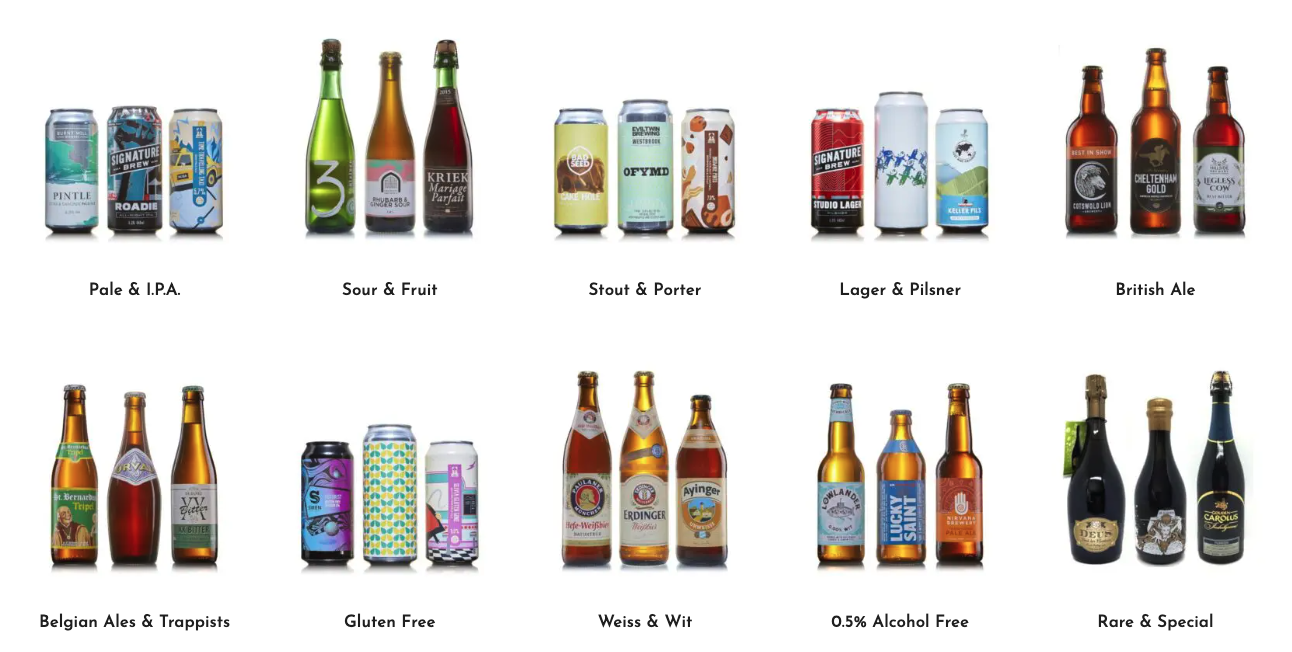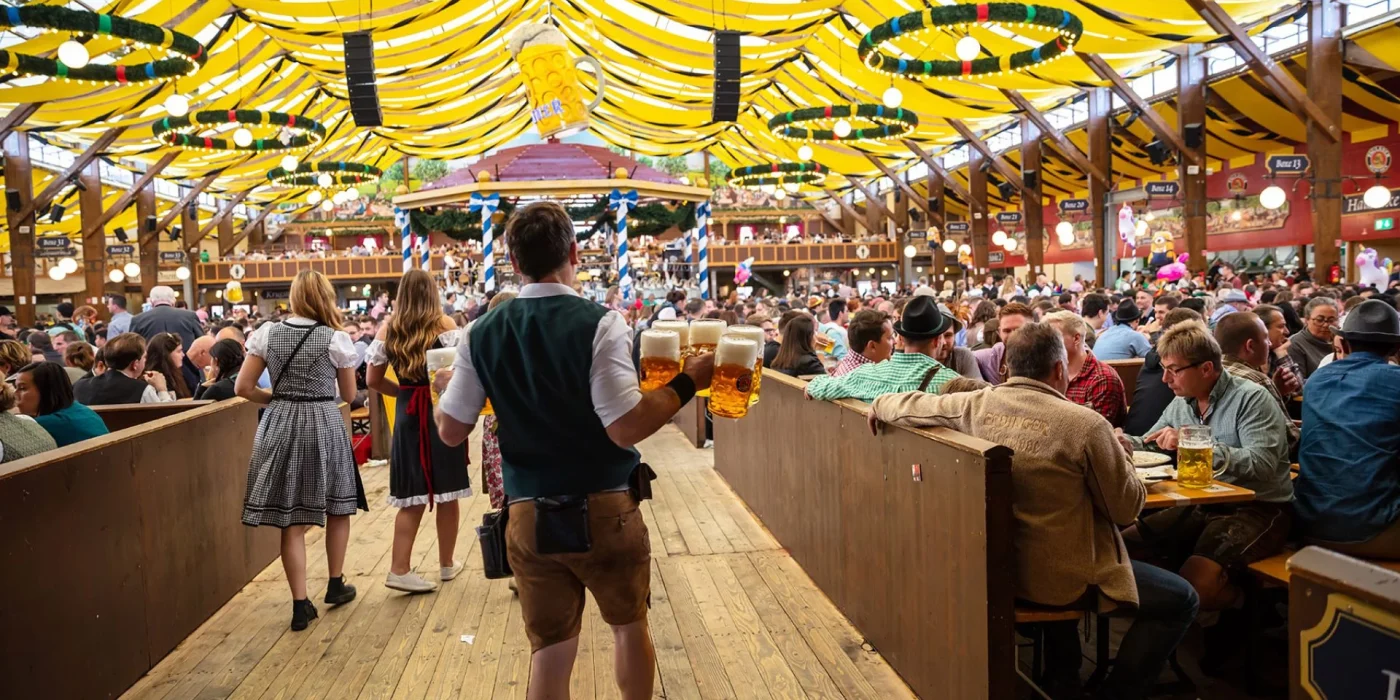Immersion into the Beer Universe
Welcome, beer enthusiasts, to the fascinating world of beer! Whether a seasoned connoisseur or a curious novice, there’s so much to learn about the myriad types of beer that grace our world.
A Quick Overview of the Beer World
The beer universe is as vast as it is diverse. From the humble beginnings of barley, hops, water, and yeast come a spectacular array of beers, each with its unique character, flavour, and history. The beauty of beer lies in its diversity, with each style offering a distinct taste experience.
In the world of beer, you’ll come across a plethora of styles, including ales, lagers, stouts, pilsners, porters, and malts. Each of these beer styles has a unique brewing process and a distinct set of flavours and aromas. Our comprehensive guide on beer styles provides an in-depth look at these different types of beer.
The Basics of Beer Making
Beer brewing is an art steeped in tradition and skill. At its core, it involves the fermentation of sugars, usually derived from malted barley, by yeast. This basic process can be tweaked and adjusted in countless ways to produce the wide array of beer styles we enjoy today.
Here’s a simplified step-by-step guide to the beer brewing process:
- Malting: Barley is soaked in water, allowed to germinate, and then dried in a kiln. This process develops the enzymes needed to convert the grain’s starches into sugars.
- Mashing: The malted barley is crushed and mixed with hot water. This activates the enzymes, breaking down the starches into sugars to create a sweet liquid known as wort.
- Boiling: The wort is boiled and hops are added for bitterness, flavour, and aroma.
- Fermentation: The wort is cooled and yeast is added. The yeast consumes the sugars in the wort, producing alcohol and carbon dioxide.
- Maturation: The beer is allowed to mature, during which it develops its full flavour and clarity.
- Carbonation and Packaging: The beer is carbonated (if necessary) and packaged into bottles, cans, or kegs.
Of course, this is a simplified explanation of the beer-making process. The actual process is much more nuanced and complex, and can vary greatly depending on the specific style of beer being brewed.
To further explore the world of beer brewing, check out our detailed article on beer ingredients. It’s a great resource for understanding the role each ingredient plays in creating the final taste and character of the beer.
So, ready to dive deeper into the beer universe? Hold on to your pint glasses as we journey through the world of ales, lagers, stouts, and more in our next sections.
The Ales
Ah, the world of ales! Ales are one of the most popular and diverse types of beer, offering an array of flavours and styles to delight beer enthusiasts everywhere.
What Defines An Ale
Ales, in essence, are beers that are fermented at warmer temperatures, compared to their colder-fermented cousins, the lagers. This fermentation process, which often involves top-fermenting yeast, is typically quicker, leading to the creation of beers that are rich and full-bodied, often revealing fruity and spicy notes.
One of the most defining characteristics of ales is their complexity – both in terms of flavour and aroma. From light and crisp, to dark and roasty, the versatility of ales is truly remarkable. They can also range significantly in terms of alcohol content, from session ales that are light in alcohol, to strong ales that pack a punch.
Exploring the Different Styles of Ales
When it comes to ale styles, the diversity is simply staggering. Here’s a look at some of the most popular ale styles:
- Pale Ales: Light in colour and often crisp in taste, pale ales are a beloved choice among beer lovers. They often showcase a balance between malt and hop flavours, with a medium to high hop bitterness.
- India Pale Ales (IPAs): IPAs are a hoppy beer style within the broader category of pale ale. They are known for their strong hop bitterness and floral, fruity flavours.
- Brown Ales: Brown ales are dark amber or brown in colour. They often have a slightly sweet malt flavour, with hints of chocolate, caramel, and nut.
- Porters: Porters are a dark style of beer originating from London. They are known for their rich, malty flavour and notes of dark fruit.
- Stouts: Stouts are typically the darkest of all beers. They often have strong flavours of roasted malt, chocolate, and coffee.
- Belgian Ales: Belgian ales are known for their complexity. They often have a high level of alcohol and can range from very pale to very dark in colour.
| Ale Style | Alcohol Content | Flavour Notes |
| Pale Ales | 4-5% | Balanced malt and hops, medium bitterness |
| IPAs | 5-7% | Floral, fruity, strong hop bitterness |
| Brown Ales | 4-6% | Sweet malt, chocolate, caramel |
| Porters | 5-7% | Rich malt, dark fruit |
| Stouts | 6-8% | Roasted malt, chocolate, coffee |
| Belgian Ales | 7-12% | Complex, varying flavours |
From traditional British ales to innovative American craft ales, there is an ale out there for every beer lover. To dive deeper into the world of ales and other beer styles, consider checking out some of the beer festivals around the world, or exploring the range of beer brands available. And of course, don’t forget to learn about the beer ingredients that go into making these delicious brews!
The Lagers
Lagers are a world unto themselves in the grand tapestry of the beer universe. Known for their crisp, clean flavours and golden hues, they are a testament to the beauty of simplicity in brewing.
What Defines a Lager
The defining factor of a lager, one of the major types of beer, is the yeast used in the brewing process. Unlike ales, lagers are brewed using a yeast strain known as Saccharomyces pastorianus, which ferments at cooler temperatures. This cool fermentation, combined with a longer aging process (lagering), results in a beer that is typically smoother and more balanced in flavour.
Lagers are often paler, less bitter, and clearer than ales. However, they can also vary in colour, flavour, and aroma depending on the specific style and the ingredients used. For an in-depth look at these ingredients, check out our article on beer ingredients.
A Look at the Various Styles of Lagers
Lagers are not a one-size-fits-all category in the beer world. There are several distinct styles of lagers, each with its own unique characteristics:
- Pilsner: Originating from the Czech Republic, Pilsners are light in colour and feature a crisp, refreshing taste with a slightly bitter hoppy finish.
- Märzen: These are traditional German lagers that are deeper in colour with a rich, toasty malt flavour.
- Doppelbock: A stronger variant of the traditional bock, Doppelbocks are full-bodied lagers with a sweet, malty flavour and a higher alcohol content.
- Helles: A German term meaning ‘light’, Helles lagers are golden, with a slightly sweet, malt-forward flavour and low bitterness.
Here’s a quick comparison of these lager styles:
| Beer Style | Origin | Colour | Taste | Alcohol Content |
| Pilsner | Czech Republic | Light | Crisp, slightly bitter | 4.5-5.5% |
| Märzen | Germany | Amber | Rich, toasty | 5-6% |
| Doppelbock | Germany | Dark | Sweet, malty | 7-10% |
| Helles | Germany | Golden | Slightly sweet, malt-forward | 4.7-5.4% |
To further explore the fascinating world of lagers and other types of beer, check out our comprehensive guide on beer styles. Each style has a story to tell, a unique place in history, and a celebration of the brewer’s art. So, the next time you’re at a beer festival, raise a glass to the amazing diversity of lagers and the joy they bring to beer enthusiasts around the globe!
The Stouts
As we continue our bubbly journey exploring the diverse types of beer, it’s time to delve into the rich and roasty world of Stouts. Known for their intense flavours and dark, almost black hues, Stouts are a dream come true for those who love their beer bold and robust.
What Makes a Stout
In the vast universe of beers, what truly sets Stouts apart is their distinctive character. These beers are typically brewed with roasted barley, which imparts a deep colour and a strong, toasty flavour. The use of roasted barley is what gives Stouts their signature dark hue and taste profiles that range from coffee to chocolate, and sometimes even hints of caramel.
What’s more, Stouts are often more full-bodied and have higher alcohol content compared to other beer styles. They are well-loved for their creamy and thick mouthfeel that leaves a lasting impression on the palate. For more insights into the ingredients used in brewing different types of beers, check out our article on beer ingredients.
Uncovering the Different Styles of Stouts
As with all types of beer, there’s a whole spectrum of Stouts to explore! Let’s dive into some of the popular styles:
- Dry Stout: Also known as Irish Stout, Dry Stouts are known for their dry, roasted character, light body, and surprisingly low alcohol content. They offer a harmonious balance of bitter and sweet flavours.
- Sweet Stout: As the name suggests, Sweet Stouts have a noticeable sweetness that is often balanced by the roasted malt. They are full-bodied and generally have a low to moderate alcohol content.
- Oatmeal Stout: In this style, oats are added to the brewing process, lending a smooth, rich body and a touch of sweetness to the beer.
- Imperial Stout: A robust variant, Imperial Stouts pack a punch with their high alcohol content. They showcase strong, complex flavours, often with notes of dark fruit, chocolate, and coffee.
- Milk Stout: Brewed with lactose, Milk Stouts are known for their sweet, creamy, and full-bodied profile.
| Stout Style | Taste Profile | Alcohol Content |
| Dry Stout | Balanced bitter and sweet | Low |
| Sweet Stout | Noticeable sweetness | Low to moderate |
| Oatmeal Stout | Smooth, rich, and slightly sweet | Moderate |
| Imperial Stout | Strong, complex with notes of dark fruit, chocolate, coffee | High |
| Milk Stout | Sweet, creamy, full-bodied | Moderate |
From the dry and balanced Irish Stout to the robust and complex Imperial Stout, each style offers a unique taste experience. Depending on your preferences, you can find a Stout that’s perfect for every season and occasion.
So the next time you find yourself at a beer festival, why not take a chance on a Stout? Who knows, you might just find your new favourite among the dark and delightful world of Stouts!
The Pilsners
Diving into the realm of beer, we’re greeted by a delightful host of Pilsners. This bright and golden member of the beer family is known for its crisp and refreshing taste.
What Is a Pilsner
A Pilsner is a type of lager that originated in the Czech city of Pilsen, earning it its distinctive name. It’s one of the most popular types of beer amongst beer enthusiasts worldwide, and for good reason. Pilsners have a light, clear colour and a rich foamy head. They’re renowned for their crisp, clear taste and a delicate balance between malt sweetness and hop bitterness.
Pilsners are brewed using bottom-fermenting yeast, which gives them a clean and smooth finish. What sets them apart is their unique blend of beer ingredients, particularly the use of noble hops. These hops lend Pilsners their signature herbal and floral aroma.
Different Styles of Pilsners
There are various styles of Pilsners, each offering a unique twist on the classic taste. Here are three main styles of Pilsners that every beer lover should know about:
- Czech Pilsner: The original Pilsner style, Czech Pilsners are known for their golden colour, high foaminess, and balanced taste. They have a medium to full body and a distinctive maltiness that is balanced by a moderate hop bitterness.
- German Pilsner: Generally lighter and crisper than their Czech counterparts, German Pilsners have a dry, clean taste. They’re more bitter and earthy, thanks to the use of German hop varieties.
- American Pilsner: Inspired by the European styles, American Pilsners have evolved to showcase local ingredients. They often have a more pronounced hop aroma and flavour, ranging from citrusy to floral, depending on the hop varieties used.
| Pilsner Style | Taste | Aroma | Color | Body |
| Czech Pilsner | Balanced, Malty | Herbal, Floral | Golden | Medium to Full |
| German Pilsner | Dry, Bitter | Earthy, Herbal | Light Golden | Light to Medium |
| American Pilsner | Hoppy, Varied | Citrusy to Floral | Varied | Light to Medium |
The world of Pilsners is vast and vibrant, offering a style to suit every palate. Whether you’re a fan of the balanced and malty Czech Pilsners, the dry and bitter German Pilsners, or the hop-forward American Pilsners, there’s a world of flavours waiting to be explored. So, why not embark on a journey through the exciting world of Pilsners at the next beer festival or delve deeper into the beer styles to discover more?
The Porters
Diving into the fascinating world of beer, porters hold a special place, offering a unique taste experience that sets them apart from other types of beer.
What Makes a Porter Unique
Porters are dark ales that originated in London in the 18th century. Named after the porters who lugged goods around the city, this beer style was beloved for its robust, hearty flavour, perfect for the hard-working folk of the time.
Porters are traditionally brewed using brown malt, which imparts a distinct colour and flavour to the beer. They are known for their rich, dark colour, ranging from brown to almost black, and their characteristic malt aroma with hints of chocolate, caramel, and coffee.
But what really sets porters apart is their complexity and depth of flavour. A good porter has a beautiful balance of sweet malt and bitter hops, creating a rich, full-bodied beer that is both refreshing and satisfying. For a deeper understanding of the ingredients that go into making beer, check out our article on beer ingredients.
Various Styles of Porters
While the classic porter is a delight in itself, there exist several variations of this beer style, each offering a unique flavour profile. Let’s take a closer look at some of the different styles of porters:
- Brown Porter: This is the traditional English style of porter. It’s lighter in colour and flavour compared to other porters, with a smooth, malty taste and subtle hops.
- Robust Porter: Originating from the United States, robust porters are darker and boast a stronger malt flavour, with hints of chocolate and coffee.
- Baltic Porter: This is a strong, dark beer that was originally brewed for export to countries around the Baltic Sea. It features a rich, sweet malt flavour with notes of dried fruit and liquorice.
| Porter Style | Origin | Key Flavours |
| Brown Porter | England | Malty, subtle hops |
| Robust Porter | United States | Strong malt, chocolate, coffee |
| Baltic Porter | Baltic Sea Region | Sweet malt, dried fruit, liquorice |
Porters, with their rich history and complex flavours, are an exciting part of the beer universe. Whether you’re a seasoned beer enthusiast or a curious novice, exploring the different styles of porters is a delightful journey into the world of beer. For more information on different types of beer, visit our comprehensive guide.
The Malts
Malt beers are an exciting category within the beer universe that every beer lover should explore. With their rich flavours and aromatic profiles, malt beers offer a unique drinking experience that distinguishes them from other types of beer.
Understanding Malt Beers
Malt beers, as the name suggests, focus on showcasing the flavours and characteristics of malted grains. These beers are typically sweet, full-bodied, and often contain notes of caramel, toffee, and nuts. The key ingredient in malt beers is, of course, the malt itself. The type of malt used, along with the roasting process, plays a crucial role in determining the beer’s colour, flavour, and aroma.
Malted grain is created by soaking it in water, allowing it to germinate, and then drying it in a kiln. This process develops the enzymes needed for fermentation and contributes to the distinctive flavours found in malt beers. For a deeper dive into the ingredients that make up our beloved brews, check out our article on beer ingredients.
Exploring the Different Styles of Malts
The category of malt beers encompasses a variety of styles, each with its own unique characteristics. Here are a few popular malt beer styles:
- English Pale Malts: These beers are light in colour and often have a balanced profile of malt sweetness and hop bitterness. They typically showcase the flavours of the malt rather than the hops.
- Brown Ales: Brown ales are darker in colour due to the use of roasted malts. These beers often boast flavours of caramel, toffee, and chocolate.
- Scotch Ales: Scotch ales, also known as “Wee Heavy,” are rich, robust, and full-bodied. They have a strong malt presence and often contain notes of caramel and dark fruit.
- Malt Liqueurs: Malt liqueurs are high in alcohol content and often sweet. They are brewed with malt and other grains, with sugar sometimes added during the brewing process.
| Beer Style | Colour | Flavour |
| English Pale Malts | Light | Balanced malt sweetness and hop bitterness |
| Brown Ales | Dark | Caramel, toffee, chocolate |
| Scotch Ales | Dark | Caramel, dark fruit |
| Malt Liqueurs | Varies | Sweet, high alcohol content |
Each malt beer style offers a unique tasting adventure, highlighting the versatility of malt as a primary ingredient. These styles just scratch the surface of the malt beer world. Be sure to explore the vast range of malt beers at local breweries, beer shops, and beer festivals!
As you continue your journey through the world of beer, remember that understanding the different styles and ingredients is key to fully appreciating the complexity of this beloved beverage. Stay curious, keep exploring, and cheers to the wonderful world of beer!
Beer Styles from Around the World
As we journey through the fascinating world of beer, let’s take a moment to appreciate how the diverse cultures of the world have contributed to the plethora of types of beer we enjoy today. Let’s embark on this exciting expedition, exploring the distinctive beer styles from Europe, America, and Asia.
European Beer Styles
Europe is often considered the birthplace of beer, where brewing has been an integral part of the culture for centuries. Each region in Europe has its own unique beer styles, coloured by the local traditions and ingredients.
For instance, Germany is known for its robust Lagers and Bocks, while Belgium boasts a rich tapestry of Ales, including the fruity Lambics and complex Trappist beers. The British Isles, on the other hand, are famous for their bitters, stouts, and porters.
For a more in-depth look at European beer styles and their rich history, check out our article on beer styles.
American Beer Styles
Across the Atlantic, American beers have carved out their own niche in the world of brewing. Known for their innovation and bold flavours, American brewers have given us a range of unique beer styles.
American Pale Ale (APA), for example, is a beer style that has gained worldwide recognition. Characterised by its strong hop flavour and aroma, APA is a testament to America’s love for hops. Other popular American beer styles include the American IPA, which is notable for its higher alcohol content and intense bitterness, and the American Stout, known for its dark, roasted flavours.
Discover more about the diverse world of American beers in our beer culture article.
Asian Beer Styles
The beer scene in Asia is as diverse as the continent itself. From the light and crisp Lagers of China and Japan to the traditional rice beers of India and Nepal, Asian beers offer a unique perspective on brewing.
Japan, in particular, has made significant contributions to the global beer landscape with styles like Sake (a rice-based beer) and Happoshu (a low-malt beer). Meanwhile, India has its own brewing tradition with beers like Toddy, made from fermented palm sap, and Chhang, a popular rice beer in the Himalayan regions.
For more insights into the unique world of Asian beers, refer to our article on beer brands.
In the grand tapestry of global brewing, these are but a few examples of how regional cultures and traditions have shaped the types of beer we know and love. So, the next time you raise a glass, take a moment to appreciate the world of flavours that beer has to offer!
Pairing Beers with Food
After exploring the diverse world of ales, lagers, stouts, pilsners, porters, and malts, the journey through the exciting universe of types of beer doesn’t end. To truly appreciate the depth and complexity that different beers offer, pairing them with the right food is crucial. Let’s dive into the art of beer and food pairing.
General Guidelines for Beer Pairing
While pairing beers with food, there are a few general guidelines to keep in mind. The goal is to find a balance where both the beer and the food can shine without overpowering each other.
- Match Intensity: Heavier, more robust dishes often pair well with darker, stronger beers. Lighter meals, such as salads or fish, go well with lighter beers.
- Find Complementary Flavours: Look for common flavor notes in the beer and the food. The caramel tones in an amber ale might complement a caramelised pork dish.
- Consider Contrast: Sometimes, contrasting flavors work best. A bitter IPA might perfectly offset a sweet dessert.
- Don’t Forget Carbonation: Beers with high carbonation can act as a palate cleanser, making them a good choice for rich, fatty foods.
- Experiment: Finally, don’t be afraid to experiment. Taste is subjective, and the best pairings are often discovered through trial and error.
Examples of Successful Beer and Food Pairings
Here are a few examples of successful beer and food pairings to get you started:
| Type of Beer | Food Pairing |
| Pale Ale | Grilled meats, spicy dishes |
| Stout | Oysters, chocolate desserts |
| Pilsner | Light seafood, sushi |
| Porter | Smoked meats, black forest cake |
| Wheat Beer | Vegetarian dishes, citrus salads |
These are just a few examples; the possibilities are endless when it comes to pairing beers with food. So, go ahead and start exploring. Attend beer festivals, experiment with different beer styles, and don’t be afraid to mix and match until you find your perfect pairings. Happy tasting!




